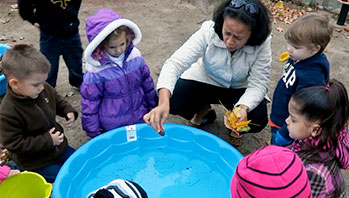- children’s bean, grass, and onion plants
- containers
- potting soil
- scissors
- small trowels
- spoons
- water
- watering can
- grow
- plant
MA Standards
English Language Arts/Language/L.PK.MA.6: Use words and phrases acquired through conversations, listening to books read aloud, activities, and play.
MA Draft Standards:
Life Sciences/From Molecules to Organisms: Inheritance and Variation of Traits/LS1/3.D: Recognize stages of the life cycle of plants and animals they have observed and discuss ideas about what happens at each stage. [Patterns, Change]
Head Start Outcomes
Logic and Reasoning/Reasoning and Problem Solving: Classifies, compares, and contrasts objects, events, and experiences.
Science Knowledge/Scientific Skills and Method: Uses senses and tools, including technology, to gather information, investigate materials, and observe processes and relationships.
Science Knowledge/Conceptual Knowledge of Natural and Physical Worlds: Observes, describes, and discusses living things and natural processes.
PreK Learning Guidelines:
English Language Arts/Language 2: Participate actively in discussions, listen to the ideas of others, and ask and answer relevant questions.
Explore Together (outdoors): Keep on Growing!

© Commonwealth of Massachusetts, Department of Early Education and Care. All rights reserved.
STEM Key Concepts: There are many different types of plants; Plants grow in many places; Plants have different parts: roots, stems, and leaves
ELA Focus Skills: Listening and Speaking, Vocabulary
Safety Tips:
- Be aware of and check for poison ivy and poison sumac before gathering children in a designated area.
- Remind children to wash their hands before and after the activity.
- Remind children not to eat ANY plants or touch any plants without asking an adult.
- Take children’s allergies into account before going outside.
Tell children they are going to move their beans, grass, and onion plants to larger containers (or an outside garden) so they will have more room for their roots and plants to grow.
Show the materials to children. Then let children explore the materials and repot their plants. Be available to help children remember how to fill the pots with soil and to help them transfer their plants. Encourage children to work together to help one another and to talk about how their plants have grown. Encourage children to notice different things about how their plants have grown. Listen and engage children to guide their discussions. Ask questions such as,
- Why do you think the plant is stuck and hard to pull out of the cup? (roots coming out the bottom)
- How do you think you can get it out of the cup without breaking the roots? What do you think would happen if you cut the side of the cup?
If possible, take children to an outdoor area to observe plants late in the life cycle. Have children think about how the plant found space to grow. Invite them to imagine what the plant looked like when it was just beginning to sprout and to compare it to its size now.
Reflect and Share
Talk with children about their growing plants. Ask, What do you think would happen to your plants if you left them in the small cup and didn’t give them a larger area to grow in?
Social Emotional Tip: Talk with children about why it is important to wash their hands after touching soil. Go over self-care routines with children, such as washing hands, brushing teeth, and taking baths. Ask children to talk about the ways they take care of themselves.
